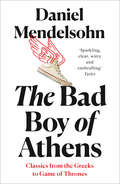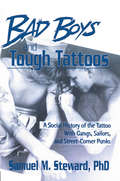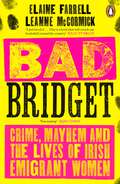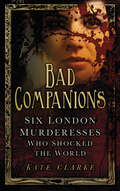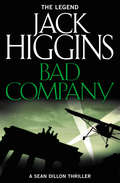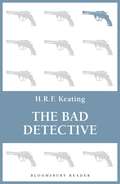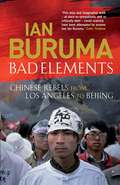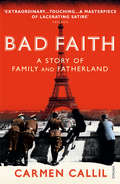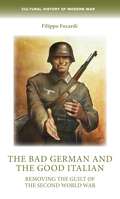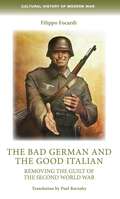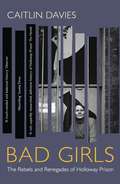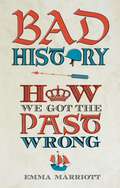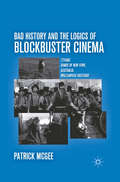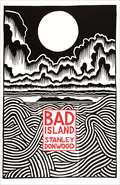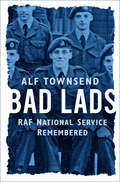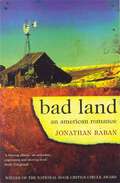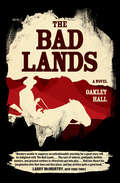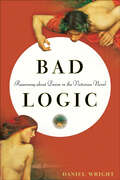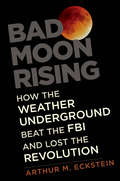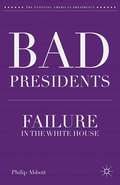- Table View
- List View
The Bad Boy of Athens: Classics From The Greeks To Game Of Thrones
by Daniel Mendelsohn‘Mendelsohn takes the classical costumes off figures like Virgil and Sappho, Homer and Horace … He writes about things so clearly they come to feel like some of the most important things you have ever been told.’ Sebastian Barry
Bad Boys and Tough Tattoos: A Social History of the Tattoo With Gangs, Sailors, and Street-Corner Punks 1950-1965
by Samuel M. Steward, PhDExplore the dark subculture of 1950s tattoos!In the early 1950s, when tattoos were the indelible mark of a lowlife, an erudite professor of English--a friend of Gertrude Stein, Thomas Mann, Andre Gide, and Thornton Wilder--abandoned his job to become a tattoo artist (and incidentally a researcher for Alfred Kinsey). Bad Boys and Tough Tattoos tells the story of his years working in a squalid arcade on Chicago’s tough State Street. During that time he left his mark on a hundred thousand people, from youthful sailors who flaunted their tattoos as a rite of manhood to executives who had to hide their passion for well-ornamented flesh. Bad Boys and Tough Tattoos is anything but politically correct. The gritty, film-noir details of Skid Row life are rendered with unflinching honesty and furtive tenderness. His lascivious relish for the young sailors swaggering or staggering in for a new tattoo does not blind him to the sordidness of the world they inhabited. From studly nineteen-year-olds who traded blow jobs for tattoos to hard-bitten dykes who scared the sailors out of the shop, the clientele was seedy at best: sailors, con men, drunks, hustlers, and Hells Angels. These days, when tattoo art is sported by millionaires and the middle class as well as by gang members and punk rockers, the sheer squalor of Bad Boys and Tough Tattoos is a revelation. However much tattoo culture has changed, the advice and information is still sound: how to select a good tattoo artist what to expect during a tattooing session how to ensure the artist uses sterile needles and other safety precautions how to care for a new tattoo why people get tattoos--25 sexual motivations for body artMore than a history of the art or a roster of famous--and infamous--tattoo customers and artists, Bad Boys and Tough Tattoos is a raunchy, provocative look at a forgotten subculture.
Bad Boys and Tough Tattoos: A Social History of the Tattoo With Gangs, Sailors, and Street-Corner Punks 1950-1965
by Samuel M. Steward, PhDExplore the dark subculture of 1950s tattoos!In the early 1950s, when tattoos were the indelible mark of a lowlife, an erudite professor of English--a friend of Gertrude Stein, Thomas Mann, Andre Gide, and Thornton Wilder--abandoned his job to become a tattoo artist (and incidentally a researcher for Alfred Kinsey). Bad Boys and Tough Tattoos tells the story of his years working in a squalid arcade on Chicago’s tough State Street. During that time he left his mark on a hundred thousand people, from youthful sailors who flaunted their tattoos as a rite of manhood to executives who had to hide their passion for well-ornamented flesh. Bad Boys and Tough Tattoos is anything but politically correct. The gritty, film-noir details of Skid Row life are rendered with unflinching honesty and furtive tenderness. His lascivious relish for the young sailors swaggering or staggering in for a new tattoo does not blind him to the sordidness of the world they inhabited. From studly nineteen-year-olds who traded blow jobs for tattoos to hard-bitten dykes who scared the sailors out of the shop, the clientele was seedy at best: sailors, con men, drunks, hustlers, and Hells Angels. These days, when tattoo art is sported by millionaires and the middle class as well as by gang members and punk rockers, the sheer squalor of Bad Boys and Tough Tattoos is a revelation. However much tattoo culture has changed, the advice and information is still sound: how to select a good tattoo artist what to expect during a tattooing session how to ensure the artist uses sterile needles and other safety precautions how to care for a new tattoo why people get tattoos--25 sexual motivations for body artMore than a history of the art or a roster of famous--and infamous--tattoo customers and artists, Bad Boys and Tough Tattoos is a raunchy, provocative look at a forgotten subculture.
Bad Bridget: Crime, Mayhem and the Lives of Irish Emigrant Women
by Elaine Farrell Leanne McCormickThe Number 1 Bestseller'A captivating account of lives previously ignored' Sunday Independent'An important, impeccably researched though eminently readable book that charts new territory' Irish Examiner* * *Ireland in the nineteenth and early twentieth centuries was not a good place to be a woman. Among the wave of emigrants from Ireland to North America were many, many young women who travelled on their own, hoping for a better life. Some lived lives of quiet industry and piety. Others quickly found themselves in trouble - bad trouble, and on an astonishing scale.Elaine Farrell and Leanne McCormick, creators of the celebrated 'Bad Bridget' podcast, have unearthed a world in which Irish women actually outnumbered Irish men in prison, in which you could get locked up for 'stubbornness', and in which a serial killer called Lizzie Halliday was described by the New York Times as 'the worst woman on earth'. They reveal the social forces that bred this mayhem and dysfunction, through stories that are brilliantly strange, sometimes funny, and often moving. From sex workers and thieves to kidnappers and killers, these Bridgets are young women who have gone from the frying pan of their impoverished homeland to the fire of vast North American cities.Bad Bridget is a masterpiece of social history and true crime, showing us a fascinating and previously unexplored world.* * * 'I just loved it!' Ryan Tubridy'Fascinating' Irish Times'Rich in detail and thorough in research' New Statesman
Bad Companions: Six London Murderesses Who Shocked the World
by Kate ClarkeThis book features the cases of six London women, each very different in temperament, age and status, who resorted to murder. Their reasons were varied: in the case of the surly maid Kate Webster, sheer temper seems the likely cause; avarice seemed to spur Catherine Wilson to murder an estimated seven times; desperation to pay for the upkeep of her two-year-old son lay behind Sarah Drake’s crime; seductive young cook Eliza Fenning was accused of serving poison with her dumplings; evil mistress Elizabeth Brownrigg whipped her servant to death in a home-built dungeon; and finally, the vicious Catherine Hayes persuaded two lovers – one of whom was her own son – to decapitate her husband in an orgy of violence. This fascinating study explores these cases in depth, and reveals whether these women were tragic, misunderstood or just plain wicked.
Bad Company (Sean Dillon Series #11)
by Jack HigginsWartime secrets threaten to topple a President – in the heart-stopping new adventure featuring Sean Dillon, from the incomparable Jack Higgins – bestselling author of Midnight Runner.
The Bad Detective (Macmillan Crime Ser.)
by H. R. KeatingJack Stallworthy is a bad detective just on the right side of corrupt. But now he's turning criminal...Detective Sergeant Jack Stallworthy has been accepting backhanders for most of his career. And why not? He's spent thirty years putting villains behind bars, surely he's entitled to a little nest-egg?Lily, the pretty wife he dearly loves, dreams of retirement on the tropical island Ko Samui, but Jack will happily settle for a bungalow in Devon. Until, that is, influential businessman Emslie Warnaby offers him paradise on a plate. All he has to do is steal one slim file from the Fraud Investigation office at police HQ. But soon Jack Stallworthy is dangerously out of his depth...
Bad Elements: Chinese Rebels from Los Angeles to Beijing
by Ian BurumaWho speaks for China? Is it the old men of the politburo or activists like Wei Jingshsheng, who spent eighteen years in prison for writing a emocratic manifesto? Is China's future to be fund amid the boisterous sleaze of an electoral cmpaign in Taiwan, or in the manoeuvres by which ordinary residents of Beijing quietly resist the authority of the state?These are among the questions that Ian Buruma poses in this enlightening and often moving tour of Chinese dissidence. Travelling through the U.S., Singapore, Taiwan, Hong Kong and the People's Republic, Ian Buruma tells the stories of Chinese rebels who dare to stand up to their rulers, exploring their chances of success in the face of the most powerful dictatorship on earth. From the exiles of Tiananmen to the hidden Christians of rural China, he brings alive the human dimension to their struggles and reveals the world's most secretive superpower through the eyes of its dissidents.
Bad Faith: A History of Family and Fatherland
by Carmen CallilBad Faith tells the story of one of history's most despicable villains and conmen - Louis Darquier, Nazi collaborator and 'Commissioner for Jewish Affairs', who dissembled his way to power in the Vichy government and was responsible for sending thousands of children to the gas chambers. After the war he left France, never to be brought to justice. Early on in his career Louis married the alcoholic Myrtle Jones from Tasmania, equally practised in the arts of fantasy and deception, and together they had a child, Anne whom they abandoned in England. Her tragic story is woven through the narrative. In Carmen Callil's masterful, elegiac and sometimes darkly comic account, Darquier's rise during the years leading up to the Second World War mirrors the rise of French anti-Semitism. Epic, haunting, the product of extraordinary research, this is a study in powerlessness, hatred and the role of remembrance.Shortlisted for the Samuel Johnson Prize.
The bad German and the good Italian: Removing the guilt of the Second World War (Cultural History of Modern War)
by Filippo FocardiIn the Axis War on the side of Germany, Mussolini's Italy was responsible for serious war crimes, especially in Yugoslavia and Greece. This 'dark side' of the fascist war, however, is not present in the national memory built after 1945. To distinguish Italy from the former German ally and avoid a punitive peace, the monarchist and anti-fascist ruling classes elaborated a master narrative that highlighted the opposition of the Italian people to Mussolini's war and the humanitarian behavior of Italian soldiers, depicted as saviors of Jews. All responsibility for the crimes committed in the Axis war was placed on the shoulders of the Germans, who thus became a convenient alibi for the national conscience.
The bad German and the good Italian: Removing the guilt of the Second World War (Cultural History of Modern War)
by Filippo FocardiIn the Axis War on the side of Germany, Mussolini's Italy was responsible for serious war crimes, especially in Yugoslavia and Greece. This 'dark side' of the fascist war, however, is not present in the national memory built after 1945. To distinguish Italy from the former German ally and avoid a punitive peace, the monarchist and anti-fascist ruling classes elaborated a master narrative that highlighted the opposition of the Italian people to Mussolini's war and the humanitarian behavior of Italian soldiers, depicted as saviors of Jews. All responsibility for the crimes committed in the Axis war was placed on the shoulders of the Germans, who thus became a convenient alibi for the national conscience.
Bad Girls: A History of Rebels and Renegades
by Caitlin DaviesLONGLISTED FOR THE 2019 ORWELL PRIZE FOR POLITICAL WRITING'Davies's absorbing study serves up just enough sensationalism - and eccentricity - along with its serious inquiry' SUNDAY TIMES'[A] revealing account of the jail's 164-year history' DAILY TELEGRAPH, 5* review'Insightful and thought-provoking and makes for a ripping good read' JEREMY CORBYN'A much-needed and balanced history' OBSERVER'Davies explores how society has dealt with disobedient women - from suffragettes to refugees to women seeking abortions - for decades, and how they've failed to silence those who won't go down without a fight' STYLISTSociety has never known what to do with its rebellious women. Those who defied expectations about feminine behaviour have long been considered dangerous and unnatural, and ever since the Victorian era they have been removed from public view, locked up and often forgotten about. Many of these women ended up at HM Prison Holloway, the self-proclaimed 'terror to evil-doers' which, until its closure in 2016, was western Europe's largest women's prison. First built in 1852 as a House of Correction, Holloway's women have come from all corners of the UK - whether a patriot from Scotland, a suffragette from Huddersfield, or a spy from the Isle of Wight - and from all walks of life - socialites and prostitutes, sporting stars and nightclub queens, refugees and freedom fighters. They were imprisoned for treason and murder, for begging, performing abortions and stealing clothing coupons, for masquerading as men, running brothels and attempting suicide. In Bad Girls, Caitlin Davies tells their stories and shows how women have been treated in our justice system over more than a century, what crimes - real or imagined - they committed, who found them guilty and why. It is a story of victimization and resistance; of oppression and bravery. From the women who escaped the hangman's noose - and those who didn't - to those who escaped Holloway altogether, Bad Girls is a fascinating look at how disobedient and defiant women changed not only the prison service, but the course of history.
Bad History: How We Got the Past Wrong
by Emma MarriottSo many historical 'truths' handed down by teachers or historians, and repeated by the press, prove on closer scrutiny to be at best misleading, and at worst deliberately falsified. Yet they are often so deeply rooted that we take them as fact - America's Founding Fathers must have been democrats, surely, and wasn't Captain Scott 'of the Antarctic' one of history's greatest leaders?Some historical 'facts' are little more than fables, distorted in the retelling; others are the result of deliberate attempts to mislead, or to cover up a discreditable past. Entertaining but authoritative, Bad History debunks a wealth of historical errors, accidental or deliberate. In doing so, it exposes many falsehoods that have wrongly - and sometimes dangerously - influenced our understanding of the world's history.
Bad History and the Logics of Blockbuster Cinema: Titanic, Gangs of New York, Australia, Inglourious Basterds
by P. McGeeMcGee studies historical representation in commodified, popular cinema as expressions of historical truths that more authentic histories usually miss and argues for the political and social significance of mass culture through the interpretation of four recent big-budget movies: Titanic, Gangs of New York, Australia, and Inglourious Basterds .
Bad Island
by Stanley DonwoodFrom cult graphic designer and long-time Radiohead collaborator Stanley Donwood comes a starkly beautiful graphic novel about the end of the world.A wild seascape, a distant island, a full moon. Gradually the island grows nearer until we land on a primeval wilderness, rich in vegetation and huge, strange beasts. Time passes and man appears, with clubs, with spears, with crueller weapons still - and things do not go well for the wilderness. Civilisation rises as towers of stone and metal and smoke, choking the undergrowth and the creatures that once moved through it. This is not a happy story and it will not have a happy ending.Working in his distinctive, monochromatic linocut style, Stanley Donwood carves out a mesmerising, stark parable on environmentalism and the history of humankind.Praise for Stanley Donwood:'I've read lots of his stuff and it's always good and I am in no way biased' Thom Yorke, lead singer of Radiohead
Bad Lads: RAF National Service Remembered
by Alf TownsendBetween 1945 and 1963, over two and a half million eighteen-year-olds were called up for National Service. Alf Townsend was one of them, and here he tells his story - the highs and lows of life as a lowly Aircraftman Second Class in the early '50s. Before national service intervened, Alf was 'heading down the criminal road at top speed', having grown up in a north London slum, where money was short and local villains were revered. This book is a warts-and-all account of Alf's time in the RAF, when he was transplanted into a completely new world of misfits and officer types, rogues and entertainers, all amusingly described in his own inimitable style.
Bad Land: An American Romance
by Jonathan RabanJonathan Raban takes you on an enthralling journey into the least populated and least known region in the United States, the Great Plains of Montana, and finds there the heart and soul of the country.Bringing to life the extraordinary landscape of the prairie and the homesteaders whose dreams foundered there, and reaching through history to the present day, Bad Land uncovers the dangerous legacy of American innocence gone sour.'Bad Land should be recognized as a blazing classic' – Sunday Telegraph
The Bad Lands: A Novel
by Oakley HallIt’s 1883 in Johnson County, in the old Dakota Territory—a rugged, wide-open landscape of rolling, red earth, prairie, and cattle as far as the eye can see. But the land is closing, the “Beef Bonanza” is ending, and the free-range cattlemen are stuck watching a way of life disappear in a blaze of drought and gunfire. An action-packed western from one of the masters of the genre, Oakley Hall’s The Bad Lands blends roundups and rustlers, whorehouses and land grabs, shoot-outs and the threat of hangings in a tale of the war between the cowboys and the cattle barons. But more than this, it is an elegy to the wild beauty of the badlands before the ranchers moved in, chased off the free-rangers, the trappers, and the tribes, and fenced it all in.
The Bad Lands: A Novel
by Oakley HallIt’s 1883 in Johnson County, in the old Dakota Territory—a rugged, wide-open landscape of rolling, red earth, prairie, and cattle as far as the eye can see. But the land is closing, the “Beef Bonanza” is ending, and the free-range cattlemen are stuck watching a way of life disappear in a blaze of drought and gunfire. An action-packed western from one of the masters of the genre, Oakley Hall’s The Bad Lands blends roundups and rustlers, whorehouses and land grabs, shoot-outs and the threat of hangings in a tale of the war between the cowboys and the cattle barons. But more than this, it is an elegy to the wild beauty of the badlands before the ranchers moved in, chased off the free-rangers, the trappers, and the tribes, and fenced it all in.
The Bad Lands: A Novel
by Oakley HallIt’s 1883 in Johnson County, in the old Dakota Territory—a rugged, wide-open landscape of rolling, red earth, prairie, and cattle as far as the eye can see. But the land is closing, the “Beef Bonanza” is ending, and the free-range cattlemen are stuck watching a way of life disappear in a blaze of drought and gunfire. An action-packed western from one of the masters of the genre, Oakley Hall’s The Bad Lands blends roundups and rustlers, whorehouses and land grabs, shoot-outs and the threat of hangings in a tale of the war between the cowboys and the cattle barons. But more than this, it is an elegy to the wild beauty of the badlands before the ranchers moved in, chased off the free-rangers, the trappers, and the tribes, and fenced it all in.
The Bad Lands: A Novel
by Oakley HallIt’s 1883 in Johnson County, in the old Dakota Territory—a rugged, wide-open landscape of rolling, red earth, prairie, and cattle as far as the eye can see. But the land is closing, the “Beef Bonanza” is ending, and the free-range cattlemen are stuck watching a way of life disappear in a blaze of drought and gunfire. An action-packed western from one of the masters of the genre, Oakley Hall’s The Bad Lands blends roundups and rustlers, whorehouses and land grabs, shoot-outs and the threat of hangings in a tale of the war between the cowboys and the cattle barons. But more than this, it is an elegy to the wild beauty of the badlands before the ranchers moved in, chased off the free-rangers, the trappers, and the tribes, and fenced it all in.
Bad Logic: Reasoning about Desire in the Victorian Novel
by Daniel Wright"Reader, I married him," Jane Eyre famously says of her beloved Mr. Rochester near the end of Charlotte Bront;«;€™s novel. But why does she do it, we might logically ask, after all he;€™s put her through? The Victorian realist novel privileges the marriage plot, in which love and desire are represented as formative social experiences. Yet how novelists depict their characters reasoning about that erotic desire;¢;‚¬;€?making something intelligible and ethically meaningful out of the aspect of interior life that would seem most essentially embodied, singular, and nonlinguistic;¢;‚¬;€?remains a difficult question.In Bad Logic, Daniel Wright addresses this paradox, investigating how the Victorian novel represented reasoning about desire without diluting its intensity or making it mechanical. Connecting problems of sexuality to questions of logic and language, Wright posits that forms of reasoning that seem fuzzy, opaque, difficult, or simply "bad" can function as surprisingly rich mechanisms for speaking and thinking about erotic desire. These forms of "bad logic" surrounding sexuality ought not be read as mistakes, fallacies, or symptoms of sexual repression, Wright asserts, but rather as useful forms through which novelists illustrate the complexities of erotic desire.Offering close readings of canonical writers Charlotte Bront;«, Anthony Trollope, George Eliot, and Henry James, Bad Logic contextualizes their work within the historical development of the philosophy of language and the theory of sexuality. This book will interest a range of scholars working in Victorian literature, gender and sexuality studies, and interdisciplinary approaches to literature and philosophy.
Bad Logic: Reasoning about Desire in the Victorian Novel
by Daniel Wright"Reader, I married him," Jane Eyre famously says of her beloved Mr. Rochester near the end of Charlotte Bront;«;€™s novel. But why does she do it, we might logically ask, after all he;€™s put her through? The Victorian realist novel privileges the marriage plot, in which love and desire are represented as formative social experiences. Yet how novelists depict their characters reasoning about that erotic desire;¢;‚¬;€?making something intelligible and ethically meaningful out of the aspect of interior life that would seem most essentially embodied, singular, and nonlinguistic;¢;‚¬;€?remains a difficult question.In Bad Logic, Daniel Wright addresses this paradox, investigating how the Victorian novel represented reasoning about desire without diluting its intensity or making it mechanical. Connecting problems of sexuality to questions of logic and language, Wright posits that forms of reasoning that seem fuzzy, opaque, difficult, or simply "bad" can function as surprisingly rich mechanisms for speaking and thinking about erotic desire. These forms of "bad logic" surrounding sexuality ought not be read as mistakes, fallacies, or symptoms of sexual repression, Wright asserts, but rather as useful forms through which novelists illustrate the complexities of erotic desire.Offering close readings of canonical writers Charlotte Bront;«, Anthony Trollope, George Eliot, and Henry James, Bad Logic contextualizes their work within the historical development of the philosophy of language and the theory of sexuality. This book will interest a range of scholars working in Victorian literature, gender and sexuality studies, and interdisciplinary approaches to literature and philosophy.
Bad Moon Rising: How the Weather Underground Beat the FBI and Lost the Revolution
by Arthur M. EcksteinA startling history of the forlorn war between the Weather Underground and the FBI, based on interviews and 30,000 pages of previously unreleased FBI documents In the summer of 1970 and for years after, photos of Bill Ayers, Bernadine Dohrn, Jeff Jones, and other members of the Weather Underground were emblazoned on FBI wanted posters. In Bad Moon Rising, Arthur Eckstein details how Weather began to engage in serious, ideologically driven, nationally coordinated political violence and how the FBI attempted to monitor, block, and capture its members—and failed. Eckstein further shows that the FBI ordered its informants inside Students for a Democratic Society (SDS) to support the faction that became Weather during the tumultuous June 1969 SDS convention, helping to destroy the organization; and that the FBI first underestimated Weather’s seriousness, then overestimated its effectiveness, and how Weather outwitted them. Eckstein reveals how an obsessed and panicked President Nixon and his inner circle sought to bypass a cautious J. Edgar Hoover, contributing to the creation of the rogue Plumbers Unit that eventually led to Watergate.
Bad Presidents: Failure in the White House (The Evolving American Presidency)
by P. AbbottBad Presidents seeks to interpret the meaning of presidential 'badness' by investigating the ways in which eleven presidents were 'bad.' The author brings a unique, and often amusing perspective on the idea of the presidency, and begins a new conversation about the definition of presidential success and failure.
